
Equisetaceae, also known as the horsetail family, is a family of ferns and the only surviving family of the order Equisetales, with one surviving genus, Equisetum, comprising about twenty species.

Dipterocarpaceae is a family of 16 genera and about 695 known species of mainly lowland tropical forest trees. Their distribution is pantropical, from northern South America to Africa, the Seychelles, India, Indochina, Indonesia, Malaysia and Philippines. The greatest diversity of Dipterocarpaceae occurs in Borneo.

Limacella is a genus of mushroom-forming fungi in the family Amanitaceae in order Agaricales. Some of the species have been classified as members of genus Lepiota. Limacella was described by mycologist Franklin Sumner Earle in 1909.

The Eriocaulaceae are a family of monocotyledonous flowering plants in the order Poales, commonly known as the pipewort family. The family is large, with about 1207 known species described in seven genera. They are widely distributed, with the centers of diversity for the group occurring in tropical regions, particularly the Americas. Very few species extend to temperate regions, with only 16 species in the United States, mostly in the southern states from California to Florida, only two species in Canada, and only one species in Europe. They tend to be associated with wet soils, many growing in shallow water. This is also reported from the southern part of India and the regions of Western Ghats hot spots.

Corsiaceae is a family of monocotyledonous flowering plants. The APG II system (2003) treats the family in the order Liliales, in the clade monocots. This is a slight change from the APG system, of 1998, which left the family unplaced as to order, but did assign it also to the monocots.

Amanita brunnescens, also known as the brown American star-footed amanita or cleft-footed amanita is a native North American mushroom of the large genus Amanita. It differs from A. phalloides by its fragile volva and tendency to bruise brown.
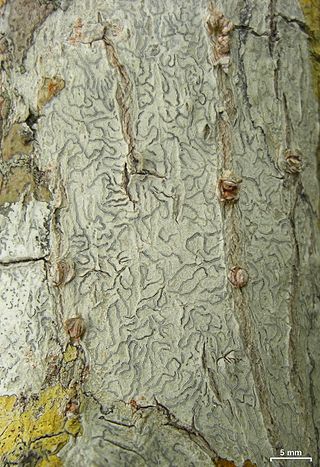
Platygramme is a genus of lichen-forming fungi in the family Graphidaceae consisting of about 30 species. The genus was circumscribed by Antoine Laurent Apollinaire Fée in 1874.
Eichleriella is a genus of fungi in the order Auriculariales. Species produce effused or cupulate, waxy to leathery basidiocarps on wood, with a smooth to spiny surface. The genus currently contains more than 15 species.

Amanita australis is a species of fungus in the family Amanitaceae. It produces small- to medium-sized fruit bodies, with brown caps up to 9 centimetres in diameter covered with pyramidal warts. The gills on the underside of the cap are white, closely crowded together, and free from attachment to the stem. The stem, up to 9 cm long, has a ring and a bulbous base. The mushroom may be confused with another endemic New Zealand species, A. nothofagi, but can be distinguished by differences in microscopic characteristics.

Limacella glischra is a mushroom species in the family Amanitaceae. It was first named as a species of Lepiota by Andrew Price Morgan in 1906; William Alphonso Murrill transferred it to Limacella in 1914.
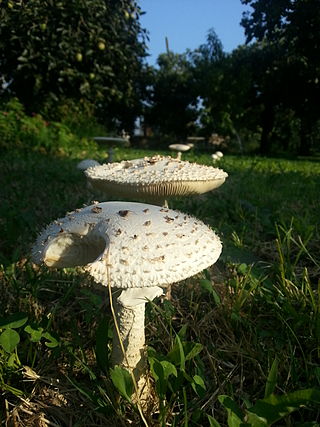
The genus Saproamanita contains about 24 species of agarics and is one of six genera in the family Amanitaceae, of which the similar Amanita is also a member. Saproamanita differs from Amanita in that its species are saprophytic, and not ectomycorrhizal.
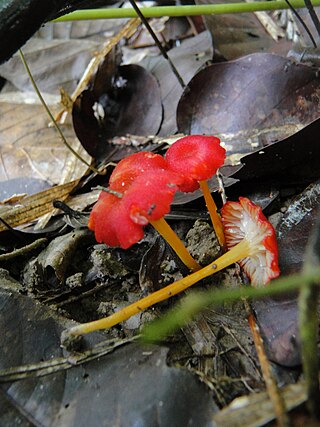
Hygrocybe umbilicata is a species of the fungal family Hygrophoraceae. This species is the first of its genus reported for Bangladesh. It was found in Singra Forest, Birganj, Dinajpur district of Bangladesh.
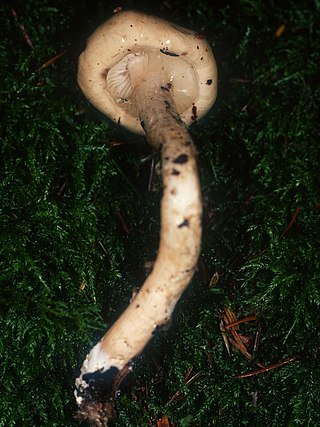
Zhuliangomyces is a genus of mushroom-forming fungi in the family Amanitaceae in order Agaricales. Analysis of DNA sequences was used to show that Zhuliangomyces was separate from Limacella which is similar in appearance and the genus name Myxoderma was adopted. The name Myxoderma was previously used for a genus of Cyanobacteria and the fungal generic name was replaced by Zhuliangomyces.
Gastrodia zeylanica is a species of potato orchids which is endemic to Sri Lanka. It was added to the 2007 Red list of Threatened Fauna and Flora of Sri Lanka as 'critically endangered', on the basis of it having only been collected from a few localities.

Amanita veldiei is a species of Amanita found in South Africa

Amanita neo-ovoidea is a species of fungus in the family Amanitaceae. It is found in China and Japan
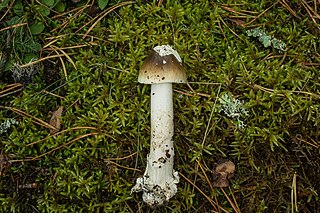
Amanita olivaceogrisea is a species of Amanita found in England, Estonia, France, Latvia, and Sweden.

Amanita rhacopus is a species of Amanita found in east coast of the United States
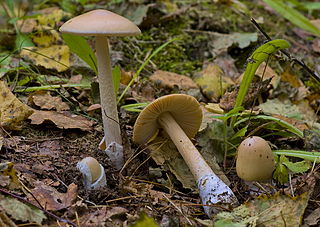
Amanita flavescens is a species of Amanita found in Sweden and Norway.















